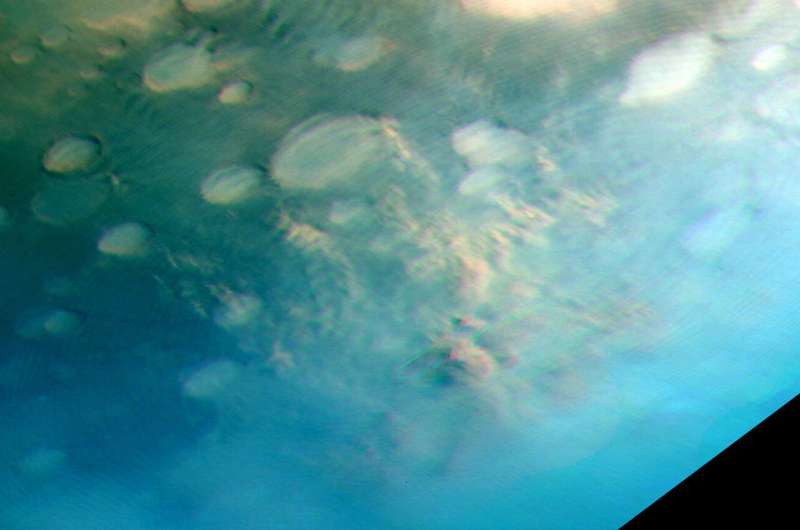
Cloud enthusiasts have a new tool to investigate striking formations in the skies above the red planet. A browsable database of 20-years-worth of images of clouds and storms, created by the German Aerospace Centre (DLR) in Berlin, is helping scientists better understand how and where features arise in the Martian atmosphere and what they can tell us about the climate of Mars and other planets.
The Mars ‘Cloud Atlas’, which is available to the public, has been presented this week at the Europlanet Science Congress (EPSC) 2024 in Berlin by Daniela Tirsch of DLR.
The images in the Cloud Atlas have been captured by the High Resolution Stereo Camera (HRSC) instrument, which has been in orbit on board the European Space Agency (ESA) Mars Express spacecraft since 2005. Although Mars has a very thin atmosphere, numerous cloud formations and dust storm phenomena can develop from water and carbon dioxide ice crystals as well as dust particles.
“Clouds on Mars are just as diverse and fascinating as those we see in our skies on Earth, with some features unique to the red planet. One of my favorite phenomena are the beautiful ‘cloud streets’—linear rows of fleecy clouds that develop around the huge volcanic Tharsis rise and the northern lowlands in northern spring and summer. While they resemble cumulus clouds on Earth, they are formed under different atmospheric conditions,” said Dr. Tirsch. “We also see impressive dust clouds that can spread hundreds of kilometers—a phenomenon we luckily don’t experience on Earth.”

Dust plays a major role in the atmosphere and climate of Mars. Rare upwelling events can leave beige, dust-laden blobs hanging in the atmosphere. Large differences in temperature and air pressure at certain seasons can result in stronger-than-usual winds that lift large amounts of dust from the Martian surface. Dust clouds spreading from the tops of giant volcanoes take on the appearance of eruption clouds, although they are no longer active.
Large spiral dust storms and cyclone systems can also be observed each year near the Martian north pole. Studying these phenomena is crucial to scientists in understanding the atmosphere and air mass circulation on Mars.
Rippling ‘gravity clouds’ are one of the most common formations on both Mars and the Earth. They are seen at mid-latitudes in winter for both hemispheres, as well as over the Tharsis volcanic plateau in southern winter. Lee waves, a special type of gravity clouds, can build up on the downwind side of ridges, mountains and other obstacles to create repeating ridge formations.
-

An example of cloud streets over Vastitas Borealis, a large area near the North Pole mostly devoid of craters. . Credit: ESA/DLR/FU Berlin/A. Cowart
-

Lee waves are a special type of cloud created by the wind encountering obstacles and build up on the ‘leeward’ or downwind side. The geometries of the lee waves depend on the shape of the obstacles. Credit: ESA/DLR/FU Berlin.
-

Lee waves are a special type of cloud created by the wind encountering obstacles and build up on the ‘leeward’ or downwind side. The geometries of the lee waves depend on the shape of the obstacles. Credit: ESA/DLR/FU Berlin.
Some types of clouds studied are specific to locations and seasons; others like ‘twilight clouds’ can appear in the early morning at any place or time of year.
The HRSC Cloud Atlas will provide valuable insights into the physical nature and appearance of clouds and storms, the time of their occurrence and their location. This knowledge will help better understand the atmospheric dynamics and the climate cycles on Mars, as well as provide input for studies of the climate on other planets such as Earth and Venus. The DLR team has already used the database to create global maps showing the occurrence of various types of cloud as a function of season and location.
“As Mars Express has been extended by ESA until at least 2026, this will enable us keep filling this database and refine even further our understand of Mars atmosphere,” said Dr. Tirsch. Papers on the database and scientific applications are currently in preparation.
Citation:
Cloud atlas of Mars showcases array of atmospheric phenomena (2024, September 10)
retrieved 10 September 2024
from https://phys.org/news/2024-09-cloud-atlas-mars-showcases-array.html
This document is subject to copyright. Apart from any fair dealing for the purpose of private study or research, no
part may be reproduced without the written permission. The content is provided for information purposes only.
